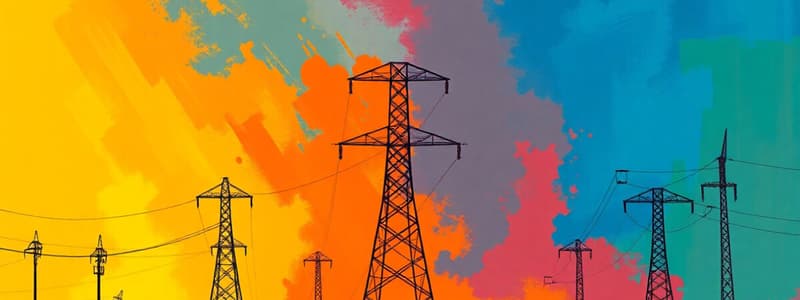Podcast
Questions and Answers
What is the primary purpose of a power substation?
What is the primary purpose of a power substation?
- To convert mechanical energy into heat energy
- To generate electricity from renewable sources
- To increase the voltage of electricity before transmission (correct)
- To store electricity for later use
Which of the following statements about electricity generation is true?
Which of the following statements about electricity generation is true?
- Turbines generate electricity directly from sunlight
- All electricity is generated from renewable energy
- Coal is the only source of electricity in the United States
- About one-third of electricity produced in the U.S. comes from coal (correct)
What form of energy does a power plant create to turn a turbine?
What form of energy does a power plant create to turn a turbine?
- Potential energy
- Electrical energy
- Heat energy (correct)
- Chemical energy
Which unit is used to measure electrical power?
Which unit is used to measure electrical power?
How does electricity travel from a power plant to homes?
How does electricity travel from a power plant to homes?
What does the voltage in an electrical circuit represent?
What does the voltage in an electrical circuit represent?
Which process is involved in converting mechanical energy into electrical energy?
Which process is involved in converting mechanical energy into electrical energy?
What is the relationship between current, voltage, and power in an electrical system?
What is the relationship between current, voltage, and power in an electrical system?
What happens to electrical energy in a refrigerator?
What happens to electrical energy in a refrigerator?
In terms of electricity, what does the term 'grid' refer to?
In terms of electricity, what does the term 'grid' refer to?
Flashcards
What is an electrical grid?
What is an electrical grid?
A connected network that carries power from the source to all the places that use it.
What is the law of conservation of energy?
What is the law of conservation of energy?
Energy can change forms, but it never goes away. Think of it like a game of tag - energy is always moving from one form to another.
How is electricity generated?
How is electricity generated?
A power plant might burn coal to create heat energy, which is then converted to mechanical energy by a turbine, and finally into electrical energy by a generator.
What is voltage?
What is voltage?
Signup and view all the flashcards
What does a power substation do?
What does a power substation do?
Signup and view all the flashcards
What are watts?
What are watts?
Signup and view all the flashcards
What are Amps?
What are Amps?
Signup and view all the flashcards
What is an electric current?
What is an electric current?
Signup and view all the flashcards
What is electrical charge?
What is electrical charge?
Signup and view all the flashcards
What is energy?
What is energy?
Signup and view all the flashcards
Study Notes
Electricity Production
- Electricity is energy that powers many appliances and systems
- Energy never disappears, it changes forms
- Power plants often use coal, a stored energy source, to generate heat.
- Heat converts water to steam, driving a turbine.
- The turbine turns a generator, which converts mechanical energy into electrical energy.
- About one-third of US electricity comes from coal.
Electricity Transmission
- Electricity travels through a connected network, called a grid.
- Electrical energy is converted and transmitted through wires.
- Power substations increase voltage before it enters the grid.
- Voltage is the pressure that pushes the electric current.
- Current flow is measured in amps (A).
- Power is measured in watts (W).
Calculating Power
- Power (watts) equals voltage (volts) times current (amps).
- W = V x A
- Higher voltage and current mean higher power.
Studying That Suits You
Use AI to generate personalized quizzes and flashcards to suit your learning preferences.
Description
Test your knowledge on the principles of electricity production and transmission. This quiz covers topics such as power generation, the role of turbines, and the electrical grid. Additionally, you'll learn how to calculate power using voltage and current.




